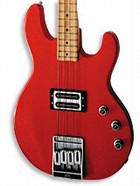
It’s been more than 25 years since the Peavey Electronics Company introduced its revolutionary T-60 guitar and T-40 bass to a market that was immediately impacted by their quality and value.
Moreover, the way the company built T-60s and T-40s – utilizing computer numerical control (CNC) routing machines and pre-stressed necks (carved with the truss rods in them), and other innovations, forever changed the guitar-manufacturing landscape.
While the T-40 remained in the line for almost a decade, a single-pickup bass known as the T-45 appeared, along with other new T-series instruments, in 1982. Initial reaction may have been that the T-45 was designed to hit a lower price point, but Hartley Peavey considered his products more dependable and a better value.
The less-popular T-45 differed from the T-40 in a number of ways besides having one less pickup. The single humbucker on the T-45 was the same as the two pickups found on the T-40, and it also had the same unique tone circuit, which allowed one coil to be “faded out” (the term used on factory price lists) to affect a single-coil sound. Also different was the location of the T-45’s “harmonically-placed” pickup. The T-40 had a phase-reverse switch, while the T-45 didn’t… but note that the T-45 has three knobs – volume, tone, and a “special mid-frequency rolloff control for maximum tonal flexibility.”
Curiously, one word was altered in price lists after ’82; the third knob was referred to as a “special low-frequency rolloff control.”
As for necks, the T-45 offered a 21-fret version, while the T-40 had 20 frets. On price lists from ’82 through ’85, the scale on the T-40 was referred to as “long;”the T-45’s scale was referred to as “34”.”
By the November ’86 price list (the last for the T-45), the T-40 had also affected the numerical description of its scale length, as well as a trademarked “Graphlon” composite nut. The T-45 spec list did not mention it.
Was the T-45 on the way out?
While some early T-45s may have been made with an oiled natural finish on an ash body (a la the original T-40s), that version didn’t appear on price lists. Instead, the single-pickup basses were first offered in Black, White, Sunburst, Blood Red, and Royal Burgundy finishes with maple fretboards at a list price of $424.50, or with a rosewood fretwood as a $25 upgrade.
And here’s the historical rub: throughout the half-decade or so that T-40s and T-45s were both offered, they (all finishes and options being equal) always carried the same list price! With the exception of the natural-finished T-40s ($399.50 with a maple neck, $424.50 with a rosewood neck in ’82), the prices for similar finishes and fretboards were equal. The T-40 retained Burgundy longer than the T-45, and the T-40 would ultimately acquire a metallic “Frost Blue” finish ($75 upgrade) while the T-45 would not. But both instruments listed for $354.50 in standard finishes. On that list, the T-40 was available in the lower-priced Natural, as well as Red and Black, while the T-45 was available in Black, White, Sunburst, or Red.
Semantics aside, the Peavey T-45 was not just a one-pickup version of the T-40. Rather, it had its own features and capabilities, and any perception that it was simply a cheaper version of the original is an unfortunate stereotype.
This article originally appeared in VG‘s June ’03 issue. All copyrights are by the author and Vintage Guitar magazine. Unauthorized replication or use is strictly prohibited.


